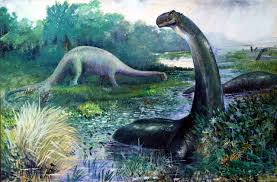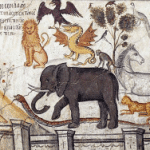Was the “Behemoth” a Dinosaur?
by Eric Lyons, M.Min.
When commenting on the behemoth of Job 40:15ff., modern scholars often make a general statement that goes something like this: “Most identify this beast as the hippopotamus.” But then they give little if any evidence to support such a claim. Another disturbing trend is how “certain” many of the critics sound when identifying this animal as a hippopotamus. For example, biblical commentator Edgar Gibson wrote: “…there can be little doubt that” behemoth corresponds with the hippopotamus (1905, p. 223). In his practical book on Job, Theodore Epp confidently affirmed: “The first animal mentioned is the behemoth or the hippopotamus” (1967, p. 175). This position has become so popular in modern times that few commentators have bothered to challenge the proposed identification of these beasts. In fact, some versions of the Bible even identify this creature in the marginal notes or chapter headings as a hippopotamus.
While it is true that a few similarities do exist between the behemoth and the hippo, some of the descriptive details simply do not (and cannot be made to) fit. For example, God described the behemoth as a creature that “moves his tail like a cedar tree” (40:17). The hippopotamus, however, hardly could be described—with its 6-8 inch stubby little appendage—as having a stiff or large tail. The tail of the hippo is short and small like that of a pig, and is a mere twig in comparison with a cedar tree. But that fact has not prevented commentators from attempting to avoid the obvious. Some believe that God is comparing the hippo’s tail to a cedar branch, not a cedar tree. Others, like John Hartley, have advocated the view that the tail is being compared to a cedar tree, rather than to a branch, but that God really was referring to the genitals of the hippopotamus. However, there is no credible evidence that suggests the Hebrew word for tail (zanab) ever was used euphemistically in Hebrew (e.g., as in regard to the reproductive organs). It appears that Hartley and others have rejected the logical rendering of the passage in order to force a comparison between the behemoth and the hippopotamus.
The behemoth is said to be “chief [i.e., largest] of the ways of God” (40:19) with bones like “beams of bronze” and “ribs like bars of iron” (40:18). Surely this would rule out the hippopotamus, since at full size it is but seven feet high and weighs about 4 tons. An elephant is twice the size of a hippopotamus, and yet even it was dwarfed by certain extinct creatures. For example, the creature once popularly referred to as Brontosaurus (now known more accurately as Apatosaurus) grew to weigh more than 30 tons. And scientists have discovered much larger dinosaurs than that. Argentinosaurus, for example, grew to weigh almost 100 tons, had 14-foot long rib bones, and left a footprint that was three feet in diameter.
The text also indicates that no man could approach the behemoth with a sword (40:19); nor were men able to capture him (40:24). Yet the hippopotamus was hunted frequently and captured successfully by the Egyptians. John Hartley observed: “Egyptian pharaohs took pride in slaying a hippopotamus. There are numerous pictures in which the pharaoh, hunting a hippopotamus from a papyrus boat, is poised to hurl his harpoon into the animal’s opened mouth, thereby inflicting a fatal blow” (1988, p. 524). Egyptians even celebrated festivals known as “Harpooning the Hippopotamus.” Additionally, Egyptian monuments frequently picture single hunters attacking the hippo with a spear. How could one accurately compare the unapproachable and unseizable behemoth with a hippopotamus?
The evidence documents overwhelmingly that the behemoth of Job 40 is a flesh-and-blood animal whose description does not fit that of any known creature present in the world today, regardless of attempts to equate it with the hippopotamus. Thus, it must be some type of extinct creature. But what kind? God’s description of behemoth is compatible in every way with the descriptions we have of some of the dinosaurs that roamed the Earth—not millions of years ago as some have suggested, but only a few thousand years ago (cf. Exodus 20:11; Genesis 1; Matthew 19:4; Mark 10:6). Yet, sadly, as Henry Morris has observed: “Modern Bible scholars, for the most part, have become so conditioned to think in terms of the long ages of evolutionary geology that it never occurs to them that mankind once lived in the same world with the great animals that are now found only as fossils” (1988, p. 115). A sad, yet true, assessment, unfortunately.
REFERENCES
Epp, Theodore H. (1967), Job, A Man Tried as Gold (Lincoln, NE: Back to the Bible Publications).
Gibson, Edgar C.S. (1905), The Book of Job (London: Methuen).
Hartley, John E (1988), The Book of Job (Grand Rapids, MI: Eerdmans).






